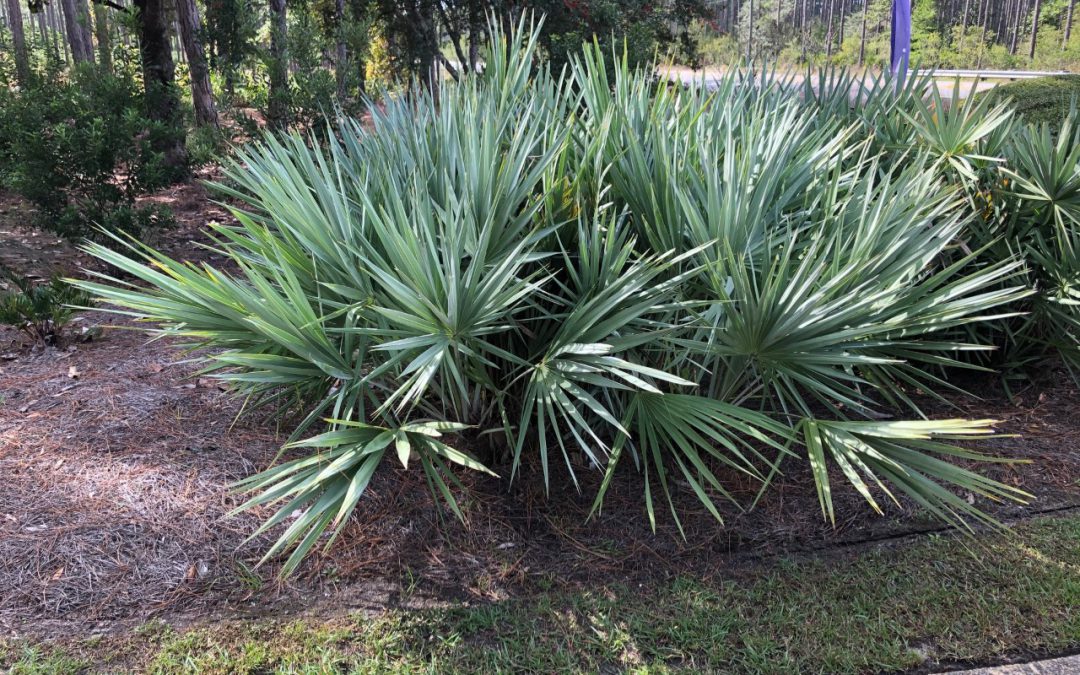
by Stephen Greer | Nov 13, 2020

Photo credit: Stephen Greer, University of Florida/IFAS Extension
Landscapes are an ever-changing setting that can be fun to view as the seasons come and go. We all have differing ideas of what an exceptional landscape should be. The point to always keep in mind is what you and your family like. Are you considering the Florida-Friendly Landscaping elements? You always want to keep a healthy, attractive environmental sound landscape. This brings many interesting design concepts to the table.
The kitchen table is exactly where a landscape design needs to begin. My dad was just the opposite, he would receive or buy plants on impulse. Load up all these three-gallon plants, take them home and plant without consideration the long-term growth, color combinations, time of bloom and many more topics. He just loved working in the yard and growing plants.
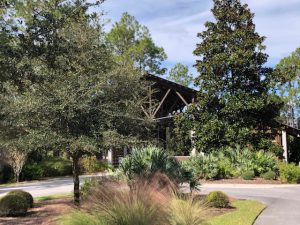
Photo Credit: Stephen Greer, University of Florida/IFAS Extension
There are basic principles of landscape design that are used as a guide. While I may stray from them from time to time, I always return to these principles. Just keep in mind that a landscape is an ever-changing living setting that we will always work to improve. The visual elements are based on what you see first when you enter a setting and are usually the vibrant high impact plants that may include bright bloom color, size of plant, focal plantings, leaf size and others. The other side of the visual is the subtle presence of low impact plants with softer colors, small leaves, lower growing plant size. This visual group often is planted en mass with a flow of plants to create a calming effect for the visitors to your landscape.
When the form of the plant is being considered, there are several points to keep in mind. Will it have a three-dimensional impact in the landscape setting? Is the landscape a small backyard or a one-acre open setting? What are the maintenance requirements of the plant(s) as they mature in size? A large tree can dominate a small area, but it may be just what is needed for shade with low plantings around it. In a large setting, multiple large trees may be needed to create a focal point. I have seen some wonderful tree alleys that help in directing the flow of the landscape down drives, walks, and paths. These forms should be considered for all plants in the landscape including, trees, shrubs, groundcovers and even hardscapes.
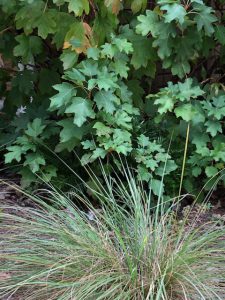
Photo Credit: Stephen Greer, University of Florida/IFAS Extension
Up next is the texture of the plant(s). Are you looking for large and coarse or small, “softer” leaves? You may find finely textured plants along paths or at entry areas to steps, softening the hardscape of the steps. Are the large leaved plants open and airy, allowing light to flow through? Large coarse leaved plants may be found at the back of landscape beds with fine textured smaller plants in front creating a three-dimensional look or even used as a focal point to pull the gaze of the eye to a determined location.
Color in the landscape has just as much impact as the plant texture, size and form. Color can bring a bold or a soft statement. The color is often thought of from blooms, but leaves too change in color with the seasons, from a fresh new bright green, purple, red or other colors in the spring to deeper, more mature colors as summer comes in. Trunks can also bring unique colors to the landscape from subtle yellows to cinnamon.
There are so many things to think about when creating a long-term vision for your landscape. Many options come in the decisions that will need to be made. Do your research and always contact your local Extension office for more information!
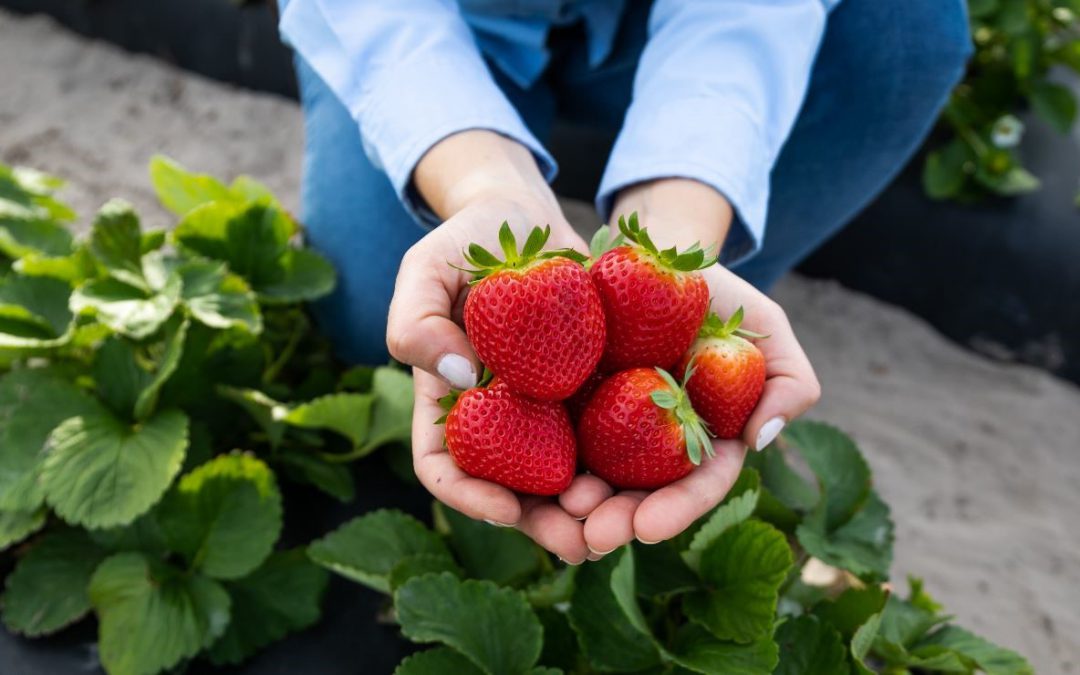
by Ray Bodrey | Nov 4, 2020
Who doesn’t like strawberries, right? Backyard gardeners grow these low-growing herbs throughout the state and there is a significant commercial industry too, as Florida’s climate is ideal for cool season production.
Strawberries like well-drained sandy soils, so they’re a perfect fit for many areas in the Panhandle. Strawberries should be planted in the months of October or November as the plants are quite cold hardy. Shorter days and temperatures between 50°F and 80°F are ideal for fruit development.
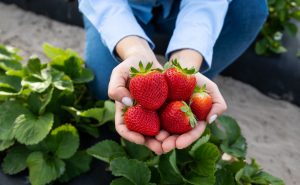
Photo Credit: Cristina Carriz, UF/IFAS
Strawberries are also very versatile. You can plant them in the ground, in raised beds or even containers. Transplants should be planted 12” to 18” apart, with 12” row spacing. For best results, use a rich soil balanced with compost and sandy soil and both fertilize and water regularly. Mixing in 2 ½ pounds of 10-10-10 fertilizer into a 10’ x 10’ bed space should be sufficient to start. A sprinkle of fertilizer applied monthly throughout the growing season should also help ensure a solid yield.
Berry production begins to ramp up roughly 90 days after planting, but plants will continue to produce throughout the spring. When the weather gets warmer, the plants start to expend energy into producing runners instead of fruit. These runners will be new fruit producing plants for next season.
Transplants can be purchased from most garden centers. There are many varieties on the market, but “Florida-Friendly” cultivars include “Sweet Charlie”, “Camarosa”, “Chandler”, “Oso Grande”, “Selva”, and “Festival”. “Camarosa” has proven to be the most productive variety in North Florida. Any of these varieties are capable of producing two pints of fruit per plant.
As stated earlier, Florida has a significant strawberry industry and UF/IFAS has a supporting role. The UF/IFAS Gulf Coast Research and Education Center (GCREC) is home to the Strawberry Breeding Program. Cultivars are developed by traditional means, for the Florida commercial industry on an 11,000+ acres research site. Appearance, shelf life, sweet flavor and disease resistance are just some of the areas of selected breading research that is conducted on site. There is also a white strawberry soon to be released!

Photo Credit: Cristina Carriz, UF/IFAS
For more information, contact your local county extension office.
Supporting information for this article can be found at the website: https://gardeningsolutions.ifas.ufl.edu/plants/edibles/fruits/strawberries.html
UF/IFAS Extension is an Equal Opportunity Institution.
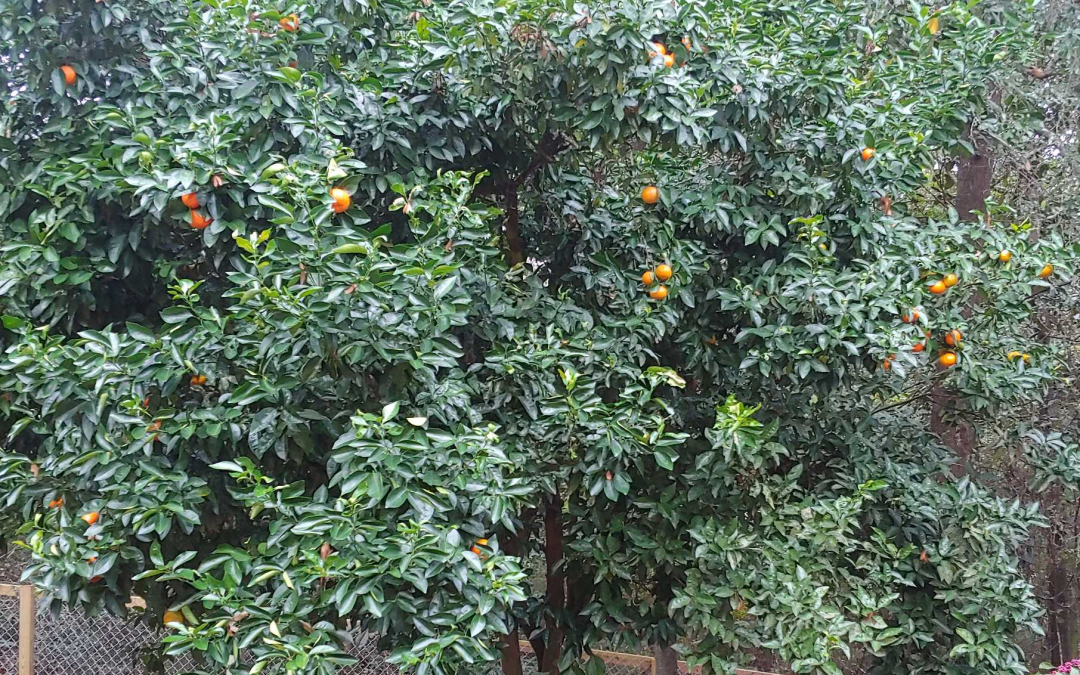
by Matt Lollar | Nov 4, 2020
From time to time we get questions from clients who are unsatisfied with the flavor of the fruit from their citrus trees. Usually the complaints are because of dry or fibrous fruit. This is usually due to irregular irrigation and/or excessive rains during fruit development. However, we sometimes get asked about fruit that is too sour. There are three common reasons why fruit may taste more sour than expected: 1) The fruit came from the rootstock portion of the tree; 2) The fruit wasn’t fully mature when picked; or 3) the tree is infected with Huanglongbing (HLB) a.k.a. citrus greening or yellow dragon disease.
Rootstock
The majority of citrus trees are grafted onto a rootstock. Grafting is the practice of conjoining a plant with desirable fruiting characteristics onto a plant with specific disease resistance, stress tolerance (such as cold tolerance), and/or growth characteristics (such as rooting depth characteristics or dwarfing characteristics). Citrus trees are usually true to seed, but the majority of trees available at nurseries and garden centers are grafted onto a completely different citrus species. Some of the commonly available rootstocks produce sweet fruit, but most produce sour or poor tasting fruit. Common citrus rootstocks include: Swingle orange; sour orange; and trifoliate orange. For a comprehensive list of citrus rootstocks, please visit the Florida Citrus Rootstock Selection Guide. A rootstock will still produce viable shoots, which can become dominant leaders on a tree. In the picture below, a sour orange rootstock is producing a portion of the fruit on the left hand side of this tangerine tree. The trunk coming from the sour orange rootstock has many more spines than the tangerine producing trunks.

A tangerine tree on a sour orange rootstock that is producing fruit on the left hand side of the tree. Photo Credit: Matt Lollar, University of Florida/IFAS Extension
Fruit Maturity
Florida grown citrus generally matures from the months of October through May depending on species and variety. Satsumas mature in October and taste best after nighttime temperatures drop into the 50s. Most tangerines are mature in late November and December. Oranges and grapefruit are mature December through April depending on variety. The interesting thing about citrus fruit is that they can be stored on the tree after becoming ripe. So when in doubt, harvest only a few fruit at a time to determine the maturity window for your particular tree. A table with Florida citrus ripeness dates can be found at this Florida Citrus Harvest Calendar.
Citrus Greening
Citrus Greening (HLB) is a plant disease caused by the bacterium Candidatus Liberibacter asiaticus, which is vectored by the Asian citrus psyllid. The disease causes the fruit to be misshapen and discolored. The fruit from infected trees does not ripen properly and rarely sweetens up. A list of publications about citrus greening can be found at the link Citrus Greening (Huanglongbing, HLB).

A graphic of various citrus greening symptoms. Photo Credit: University of Florida/IFAS Extension
by Sheila Dunning | Nov 4, 2020

Camellia
Photo by Kathy Warner
UF/IFAS Master Gardener – Nassau County
With their shiny green leaves, compact growth habit and unique blooms, camellias are the winter queen of flowering shrubs. Worldwide, there are about 250 different species of camellias. In the landscapes of Northwest Florida, the most commonly grown species are Camellia sasanqua, Camellia japonica and hybrids of these. Collectors and botanical gardens may have Camellia reticulata, Camellia hiemalis, Camellia vernalis and hybrids of multiple species. The young leaves of another camellia species, Camellia sinensis, are processed for tea, one of the world’s most common beverages. The various species of camellia plants are generally well-adapted to acidic soils, especially those rich in organic material. Camellias requires consistent watering, particularly once the flower buds are set. Most species prefer protection from direct sun during the heat of the day and will bloom well in significantly shaded areas. Individual species and cultivars bloom seasons vary with growing climate. Camellias are classified by their blooming time, ranging from early to late season, relative to other camellias. For extended flowering, plant a variety of cultivars. Early-fall bloomers begin in October and re-bloom through January. Long-bloomers add a few months with flowers from November to April. Camellias that start opening in January and continue through March are referred to as mid-season bloomers. Spring blooming camellias are the last to flower, from March to May. When deciding on particular cultivars also consider the various flower shapes. There are six flower forms, with changes in number of petals and appearance of stamens. 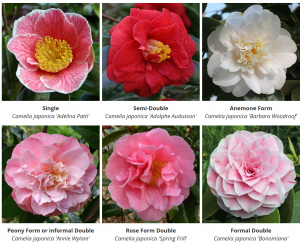 Camellias do come with a few potential pest problems. For information refer to: https://gardeningsolutions.ifas.ufl.edu/care/pests-and-diseases/pests/camellia-pests-and-problems.html
Camellias do come with a few potential pest problems. For information refer to: https://gardeningsolutions.ifas.ufl.edu/care/pests-and-diseases/pests/camellia-pests-and-problems.html
COVID 19 has resulted in many cancelled events. But, you may find a local camellia show to see some the fantastic blooms of many different cultivars. Here are a few options:
December 12, 2020
Pensacola Camellia Club, University of West Florida, Conference Center & Ballroom, 11000 University Parkway, Building 22, Pensacola, FL, Skip Vogelsang, (850) 776-7951, lbv3rd@gmail.com
January 10, 2021
Northshore Camellia Club, Southern Hotel, 428 E. Boston St., Covington, LA, Show Chairman: Hunter Charbonnet, hcherbo1@gmail.com, Contact, Judges’ Chair & Show Reporter: James Campbell, rivercamellia@bellsouth.net, (985) 630-9899,
January 16, 2021
Ozone Camellia Club, Slidell Municipal Auditorium, 2056 Second Street, Slidell, LA, Show Chairman: Jim Campbell, rivercamellia@bellsouth.net, Show Contact: Bruce Clement, (985) 259-5527, bwc555@charter.net, Show Reporter: Stella Allen,
January 23, 2021
Camellia Club of Mobile, The Shoppes at Bel Air, 3299 Bel Air mall.,Mobile, AL 36606, Show Chairmen: Walter Creighton & Larry Heard, larry_heard@bellsouth.net, Show Contact: Larry Heard, (251) 661-9392, Judges’ Chair: Jim Smelley, Show Reporter: Jim Dwyer,
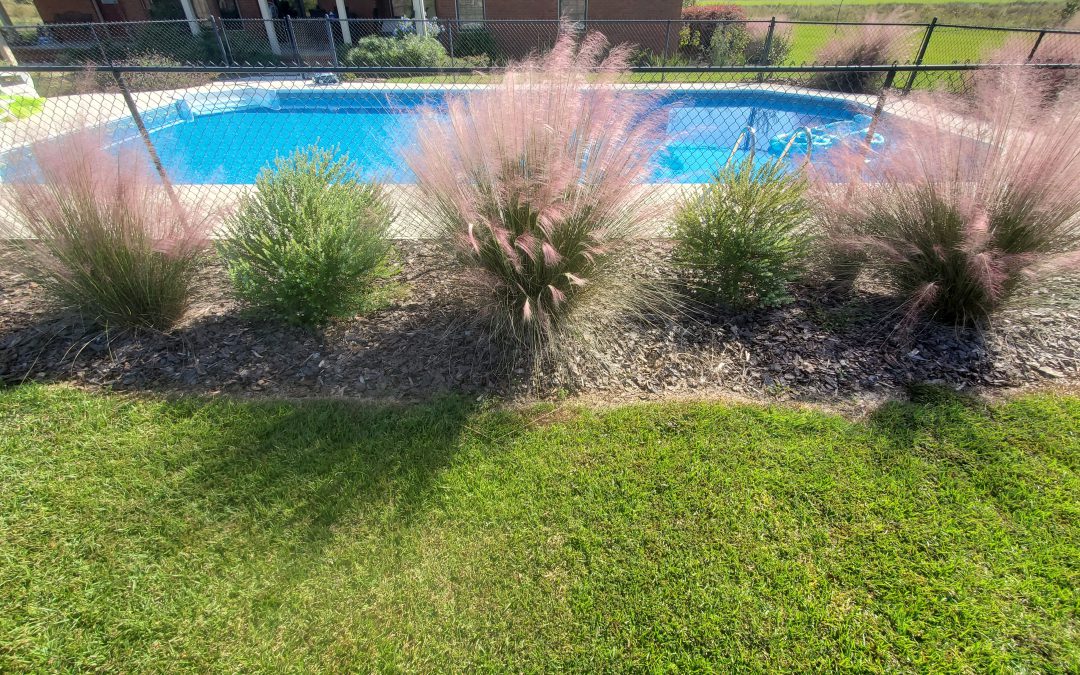
by Daniel J. Leonard | Oct 28, 2020
In the Panhandle, fall is the prettiest season for wildflowers. Our roadsides and woodlands are covered with pinks, whites, yellows, blues, purples, and even a little red here and there. Pretty as it may be, the beautiful wildflower look isn’t super appropriate for most yards. It would look unkempt, a little “wild” if you will, would be hard to manage and is probably best enjoyed in natural areas. However, we can bring some of the native colors of fall into our landscapes in a much lower maintenance, refined manner with two Panhandle species that pair excellently together, Muhly Grass (Muhlenbergia capillaris) and Darrow’s Blueberry (Vaccineum darrowii).
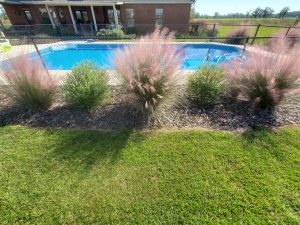
Muhly Grass and Darrow’s Blueberry in a local landscape. Photo courtesy of Daniel Leonard.
Muhly Grass, the native grass with the pinkish/purple panicles blooming right now, has gained much popularity in recent years, earning a reputation as a near pest/disease free, drought tolerant, attractive landscape plant. Operating in lieu of more traditional low growing shrubs in landscapes, Muhly is an airy, greenish gray bunch grass growing about 3-4’ tall and wide, lending informal, coastal texture to landscapes most of the year and really shining in fall during its flowering season. Once established, it never needs extra water, prefers little fertilizer, and only needs a rejuvenation prune (or burn – the Leonard preferred method. It’s fun and mimics the role of fire in Muhly’s native ecosystems!) every couple of years to keep it looking tidy.
Unlike Muhly Grass, Darrow’s Blueberry has not caught on broadly in the landscape industry but is no less deserving. This native blueberry species only grows a couple of feet tall, produces edible fruit that wildlife enjoy, and adds an unusual blue green color to landscapes via its tiny-leaved, evergreen foliage. It prefers the same sites as Muhly and is part of the reason they pair so well together. Our mostly sandy, well drained soils work just fine, but both plants can handle soils that are occasionally wet. A bonus, Darrow’s also has tiny, bell shaped flowers in spring that attract all manner of beneficial bee species. This makes it a must in any native pollinator garden!
As good as these species are alone, I think they are better together. In my family’s yard, we created a loose screen of widely spaced (8’ apart) Muhly Grass specimens around a pool, in the spirit of giving the area a “coastal” airy feel, and interspersed Darrow’s Blueberry in between.
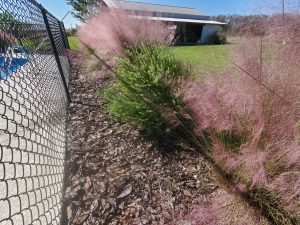
The pink Muhly Grass flowers pair nicely with the green blue foliage of Darrow’s Blueberry. Photo courtesy of Daniel Leonard.
The look has been outstanding, particularly in the late summer/early fall. The pinky purple flowers of Muhly Grass complement the green-blue foliage of the blueberries nicely and provide easy, lasting color without having to worry about planting finicky annuals or perennials each season.
Landscaping with natives does not have to look wild and unkempt, nor does it have to be drab and unattractive. Combining native yet showy plants like Darrow’s Blueberry and Muhly Grass makes for an unusual, refined, nearly no-maintenance feature in your landscape. Look for these and other neat native plants at native nurseries and independent garden centers around the Panhandle. If you’d like more information on native grasses, blueberries or any other horticultural topic, please contact your local UF/IFAS County Extension Office! Happy Gardening!















